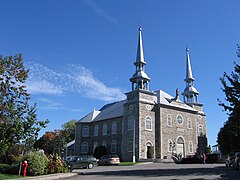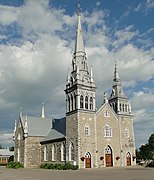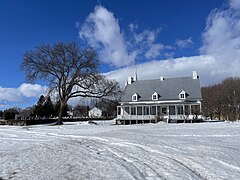
Sir Jean Lomer Gouin, was a Canadian politician. He served as 13th premier of Quebec, as a Cabinet minister in the federal government of Canada, and as the 15th lieutenant governor of Quebec.
Portneuf County is a historic county in Quebec, Canada west of Quebec City on the Saint Lawrence River in Canada.

Saint-Casimir is a municipality of about 1800 people in the Portneuf Regional County Municipality in the province of Quebec, Canada. It is located on the Sainte-Anne River, about 80 kilometres (50 mi) southwest of Quebec City and 50 kilometres (31 mi) northeast of Trois-Rivières. It was founded in 1836 by people who came from Ste-Anne-de-la-Pérade following to the east along the Sainte-Anne.

The Sainte-Anne River, a north shore tributary of Saint Lawrence River, the mouth river is located at Sainte-Anne-de-la-Pérade. This river flows in the province of Quebec, Canada.
Administrative regions
Capitale-Nationale:
Mauricie:

The Chemin du Roy is a historic road along the north shore of the St. Lawrence River in Quebec. The road begins in Repentigny and extends almost 280 kilometres (170 mi) eastward towards Quebec City, its eastern terminus. Most of the Chemin du Roy today follows along the present-day Quebec Route 138. The expressway that replaces both Route 138 and the Chemin du Roy through most of its course is Quebec Autoroute 40.
Jacques-Félix Sincennes was a Quebec businessman and political figure.

Batiscan is a municipality in the Mauricie region of the province of Quebec in Canada. It is located along the St Lawrence River at the mouth of the Batiscan River.
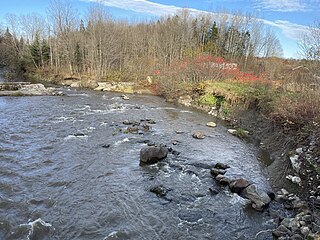
Saint-Alban is a municipality in the Capitale-Nationale region of Quebec, Canada, known for its caves, crevices and rock-climbing walls at the gorge of the Sainte-Anne River.
Nicolas Lefrançois was a land surveyor and political figure in Lower Canada. He represented Montmorency in the Legislative Assembly of Lower Canada from 1836 until the suspension of the constitution in 1837.
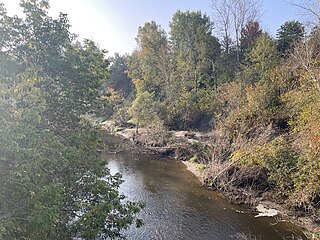
The Charest River originates from Charest Lake in the Montauban-les-Mines area, located in the eastern part of Notre-Dame-de-Montauban, within the Mekinac Regional County Municipality, in the administrative region of Mauricie in the province of Quebec, Canada. It flows southward, passing through several regions and receiving water from lakes such as Mine, Perron, Perreault, and End in its upper course.
Thomas de Lanouguère was a soldier, seigneur and administrator in New France. He was acting governor of Montreal in 1674. His descendants adopted the surnames Lanaudière, Tarieu de Lanaudière and Tarieu de La Pérade.

St. Lawrence Estuary stretches from west to east for 655 km, from the outlet of Lake Saint Pierre to Pointe-des-Monts, where it becomes the Gulf of St. Lawrence, in Quebec, Canada.
The Rivière Jacquot is a tributary of the Sainte-Anne River flowing in the municipalities of Saint-Léonard-de-Portneuf and Sainte-Christine-d'Auvergne, in the MRC Portneuf Regional County Municipality, in the administrative region of Capitale-Nationale, in Quebec, in Canada.
The Mauvaise river is a tributary of the Bras du Nord flowing in the town of Saint-Raymond, in the Portneuf Regional County Municipality, in the administrative region of Capitale-Nationale, in Quebec, in Canada.

La Chevrotière is a tributary of the northwest shore of the Saint-Laurent river, descending in the municipality of Portneuf, Saint-Gilbert and Deschambault-Grondines, in the Portneuf, in the administrative region of Capitale-Nationale, in Quebec, in Canada.
The Rivière des Pins is a freshwater stream, in Quebec, in Canada. This river crosses the municipalities of:
Portneuf was an electoral district of the Legislative Assembly of the Parliament of the Province of Canada in Canada East, immediately west of Quebec City. It was created in 1841 and was based on the previous electoral district of the same name for the Legislative Assembly of Lower Canada. It was represented by one member in the Legislative Assembly.

The rivière du Moulin is a tributary of the northwest shore of the Saint-Laurent river, descending in the municipality of Deschambault-Grondines, in the Portneuf Regional County Municipality, in the administrative region of Capitale-Nationale, in Quebec, in Canada.
The Rivière des Étangs is a tributary of the rivière du Moulin, descending in the municipality of Saint-Casimir and Deschambault-Grondines, in the Portneuf Regional County Municipality, in the administrative region of Capitale-Nationale, in Quebec, in Canada.



